Why is a Phonics and Sight Words program important?
An explicit, systematic approach to the teaching of phonics and word recognition skills is recognised as foundational to reading and writing development. Every comprehensive government review of reading instruction, including the United States, the United Kingdom, and Australia, outline that a cohesive and explicit literacy program – one that includes the development of phonemic awareness and word recognition in conjunction with the reading of whole texts – is essential for reading acquisition. These curriculum documents are informed by research which highlights how an explicit and systematic phonics program that includes whole word recognition is central for teaching children to become expert readers (Castles, Rastle and Nation, 2018).
The following outlines government curriculum documents that pinpoint the teaching of a structured and systematic phonics and sight words program in early childhood education:
- United States – K – 3 Common Core Standards (CCSS) outlines that an explicit, systematic approach to teaching phonics and word recognition skills is foundational to reading development in the child’s later years. Common Core Standards and Best Practices: Phonics and Word Recognition
- Australia – F – 2 Learning Area Content Descriptors (ACARA) include Alphabet and Phonic Knowledge as a core element of language and literacy acquisition in the Foundation to Year 2 years. Australian Curriculum: English Foundation to Year 10
- United Kingdom – Key Stages 1 and 2 English program outlines that development of word reading, spelling and language skills requires a rigorous and systematic phonics program. National Curriculum in England: English Programmes of Study: Key Stages 1 and 2
Informed by the latest in reading research and best practice, LiteracyPlanet understands that learning to read and write requires an understanding of how letters and combinations of letters make up particular sounds and words. Without knowledge of letter-sound (grapheme/phoneme) correspondences, learners lack the ability to recognise and produce known words and learn new ones when reading and writing (Hordacre, Moretti and Spoehr, 2017). Therefore, to acquire this understanding, systematic, regular explicit instruction has been shown to be the most effective for developing phonemic awareness (Bayetto, 2018).
How is LiteracyPlanet’s Phonics Program designed?
LiteracyPlanet’s Phonics Program is designed to encapsulate the best pedagogical principles, theories and strategies that inform the most effective phonics programs. These phonics programs include Jolly Phonics, Letters and Sounds, Soundwaves, Words Their Way, and many more. A result of this research and development is an explicit, systematic, synthetic teaching of phonics, incorporating the phonological and phonemic awareness skills that is pivotal to English language and literacy acquisition.
LiteracyPlanet’s Phonics program includes the following best practices that are recognised as foundational to effective reading:
- a sequence of learning that develops phonological awareness and phonemic awareness (Rose, 2006; National Early Literacy Panel, 2008);
- explicit teaching and guided practice with decreasing levels of support (National Inquiry into the Teaching of Literacy, 2005; Castles, Rastle and Nation, 2018);
- systematic phonics instruction of the sound/letter relationships in a clearly defined sequence (National Inquiry into the Teaching of Literacy, 2005; Fisher, Frey and Hattie, 2016);
- synthetic phonics – the ability to sound out each letter and then synthesise the sounds in a word together in order to generate the pronunciation of the word (Johnston and Watson, 2005; Rose, 2006; Machin, McNally and Viarengo, 2018);
- explicit teaching of decoding skills rather than guessing the words based on context (National Reading Panel, 2000; Fielding-Barnsley and Hay, 2012);
- combination of phonics, vocabulary and comprehension instruction in one cohesive literacy program (National Reading Panel, 2000; Castles, Rastle and Nation, 2018).
LiteracyPlanet’s Phonics Program provides explicit teaching sessions in grapheme-phoneme correspondences. These sessions (known as “Missions”) model the pronunciation of the sounds letters make and demonstrate how to blend letters in order (initial, medial and final) through a word. Through an incremental sequence, learners are taught how to decode a small group of letter sounds, including their pronunciation and grapheme combination within known words (e.g. /ay/ in say, /er/ in farmer, etc.). As each learner is at a different stage of phonemic awareness, our adaptive program explicitly scaffolds their understanding of each phoneme and its associated graphemes.
How does LiteracyPlanet’s Phonics Program work?
Each mission is specifically dedicated to teaching each phoneme of the English language and its associated graphemes. Through repetition, consisting of instructional videos, games and activities, students learn grapheme/phoneme correspondences: the 44 phonemes of the English language, represented by 26 letters of the alphabet in multiple grapheme combinations.
The instructional videos introduce learners to one grapheme at a time. These videos provide instruction regarding the name, shape (upper and lower case) and the most common sound (phoneme) associated with the single-letter grapheme. Correct letter formation is explicitly demonstrated. Each subsequent video introduces students to two- and three-letter graphemes and the associated phoneme/s.
The games enable the learner to practice:
- identifying the phoneme/grapheme correspondences;
- blending sounds into words and segmenting words into sounds; and,
- placing the words in written context in order that the learner can apply their knowledge when reading and writing.
Thus, when using LiteracyPlanet’s Phonics Program, the learner acquires phonemic awareness to help decode words that represent each phoneme in the English language. The Teacher Assignment Tool also enables the teacher to assign phonemes, either individually or as a bundle to their students. The teacher can choose to organise their own sequence of missions or let LiteracyPlanet’s adaptive learning program do the work.
The following table illustrates how LiteracyPlanet’s Phonics Program specifically includes each grapheme/phoneme correspondence:
| Consonants | Example Words | Vowels | Example Words |
| /b/ | bad | /ɑ:/ | father arm |
| /d/ | dog | /ɒ/ | hot |
| /ð/ | this | /æ/ | cat |
| /dʒ/ | gem jug | /aɪ/ | mindfine
pie high |
| /f/ | ifpuff
photo |
/aʊ/ | out cow |
| /ɡ/ | gum | /ɛ/ | hen head |
| /h/ | how | /eɪ/ | saycame
bait |
| /j/ | yes | /ɛə/ | air |
| /k/ | catcheck
key school |
/əʊ/ | coldboat
cone blow |
| /l/ | leg hill | /ɪ/ | hit |
| /m/ | man | /ɪə/ | beer |
| /n/ | man | /iː/ | shebead
see scheme chief |
| /ŋ/ | sing | /ɔː/ | launchraw
born |
| /θ/ | both | /ɔɪ/ | coin boy |
| /p/ | pet | /ʊ/ | book |
| /r/ | red | /ʊə/ | tour |
| /s/ | sitmiss
cell |
/uː/ | roomyou
blue brute |
| /ʃ/ | she chef | /ʌ/ | cup |
| /t/ | tea | /ɜː/ | fernturn
girl |
| /tʃ/ | check | /ə/ | farmer |
| /v/ | vet | ||
| /w/ | wet when | ||
| /z/ | ziphens
buzz |
||
| /ʒ/ | pleasure |
LiteracyPlanet’s Phonics Games (K – 4)
Each Phonics game is designed to enable the student to acquire the building blocks of phonemic awareness, particularly through the teaching of synthetic phonics.
These building blocks include:
- isolating the initial and final sound
- recognising and distinguishing between similar sounds
- blending one-syllable and two-syllable words
Sound Train
- isolating the initial and final sound
Sound Train is designed to help students recognise the sounds that words make. The student is asked to identify and place the objects beginning or ending with the phoneme displayed in a graphemic form (/s/ is the grapheme for the phonemic sound /s/ in /sat/). This process of detecting the initial or final phonemic sound in words (/c/ in /cat/ or /g/ in /dog/) helps the student understand that words consist of a sequence of sounds, leading to them being able to recognise words based on the sounds of each letter (Buckingham, 2016).
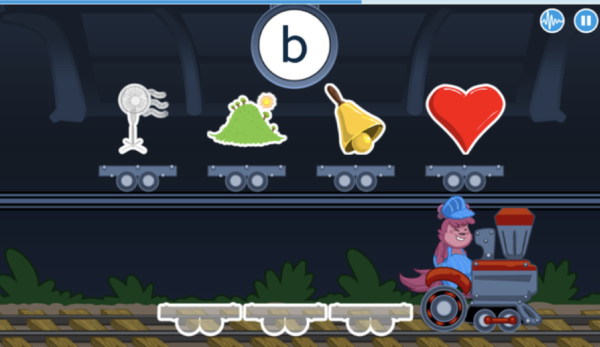
Literacy researchers highlight how the ability to isolate sounds is a pivotal step in developing phonemic awareness. The drag and drop mechanic of the game also increases student engagement by rewarding them for identifying the correct sound.
Stubmunk Slam
- recognising and distinguishing between similar sounds
Stubmunk Slam helps students recognise the sound that individual letters make. This ability to recognise the phonemic sound of individual letters (the /b/ phonemic sound is represented by the grapheme /b/) is foundational to a reader’s understanding of how to decode whole words (Vaughn & Linan-Thompson, 2004). Stubmunk Slam encourages students to recognise each phoneme – the smallest unit of speech sound – by saying the sound, showing the grapheme and then asking the student to select the stubmunk holding a card that matches the sound they hear.
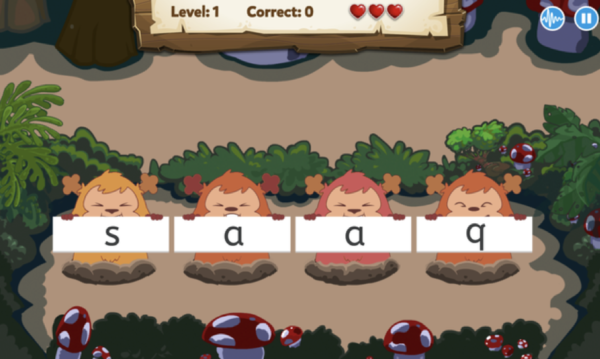
Stubmunk Slam’s mechanics includes levelling up, points for identifying the correct sound and continuous feedback on their behaviour. As the game progresses, the challenge increases as students are required to recognise the sound at increasingly faster and faster intervals.
Monster Chef
- blending one-syllable and two-syllable words
Monster Chef is a game based around phonemic spelling. The challenge is for students to spell a word correctly by listening to the word and its phonemic segments and then spell it out using the graphemes provided. The student is required to drag and drop the correct letter combinations to make the word they hear. When the student correctly spells the word, their avatar will cook a meal to feed Word Monster. When the student misplaces a word, the meal burns, and the student is prompted to find the correct letter or letter combination to spell the word.
![]()
The ability to recognise the individual sounds that make whole words is essential for reading and writing effectively (Vaughn & Linan-Thompson, 2004). Monster Chef’s game mechanics reinforce the correct spelling of words whilst inspiring the student to continue practicing their spelling.
How does LiteracyPlanet’s Sight Words Program work?
LiteracyPlanet’s Sight Words Program includes all the words that do not follow the rules of the English language: i.e. the words that cannot be sounded out phonetically. These words amount to over 290 words, ensuring that students work with all the vocabulary they need in the early stages of literacy development.
There is a total of 56 Sight Words Lists in LiteracyPlanet’s Sight Words program, starting with Set 1 – Ant and ending with Set 56 – Dinosaur. These sight words are levelled according to their frequency:
Set 1 – Ant includes the first level of the most frequently sighted words
Set 2 – Bug includes the second level of the most frequently sighted words
Set 3 – Beetle includes the third level of the most frequently sighted words
Each set progresses to the final level, Set 56 – Dinosaur.
These sight word lists are an amalgamation of the high-frequency words as identified by top literacy programs: Magic Words, Dolch and Fry, Oxford Wordlist and other high-frequency word lists. These programs level their sight words according to their frequency (i.e. how often the student is exposed to these words in their day-to-day lives and within the texts they are reading). LiteracyPlanet’s sight words are levelled the same way.
To indicate progress, LiteracyPlanet’s sight words are levelled through the representation of animals, starting from the humble ant to the powerful dinosaur. In this way, the student can see their progress by the size and characteristics of the animal. This hierarchy adds to each student a sense of accomplishment as they progress through the program.
Although LiteracyPlanet’s Sight Words program includes all high frequency words, the teacher can add their own word list through using the Custom Word List assign tool. After the student has become proficient with the list entered by the teacher, the student will then continue on the sight words pathway assigned by the program.
The following table provides an example of how LiteracyPlanet’s Sight Words Program includes the most frequently used words in the English language.
| List Name | Words | List Name | Words |
| Set 1 – Ant | the | Set 2 – Bee | my |
| I | a | ||
| to | of | ||
| was | we | ||
| Set 3 – Beetle | they | Set 4 – Butterfly | he |
| is | so | ||
| be | you | ||
| that | said |
SIGHT WORDS GAMES (K – 3)
Each Sight Words game is designed to enable the student to develop automaticity in word recognition.
Feed Word Monster
- automatic word recognition
Feed Word Monster develops students’ word recognition ability, where they focus their attention on feeding Word Monster the word they see and hear. In line with the Look, Cover, Write, Check pedagogical method, the game develops automatic word recognition skills. The process of correctly identifying the right word is rewarded with a happy monster but a word incorrectly placed results in Word Monster rejecting the word, creating amusement (Word Monster burps) but reinforces the student’s desire to feed Word Monster the words they hear.
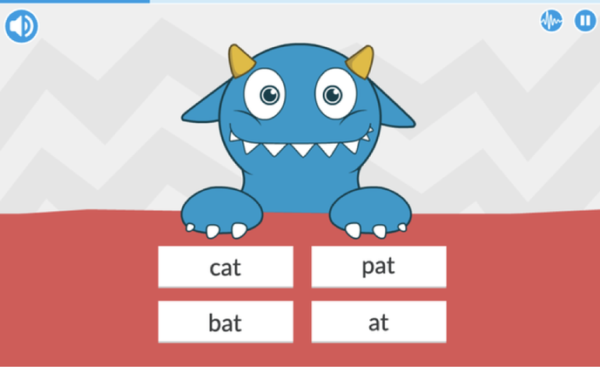
Feed Word Monster’s game mechanics encourage students to practise word recognition and be rewarded in real-time.
Stubmunk School
- automatic word recognition
Stubmunk School helps students to recognise Sight Words and build their Sight Word vocabulary by recognising each word’s relationship to other words. The student’s goal is to place the word they see and hear in the correct place within an example sentence. Reading and writing researchers highlight how the ability to automatically and accurately read sight words plays a key role in the areas of reading fluency and comprehension (Gibbon, Duffied, Hoffman & Wageman, 2017). In Stubmunk School, each sentence is designed to help the student recognise the meaning of the word.
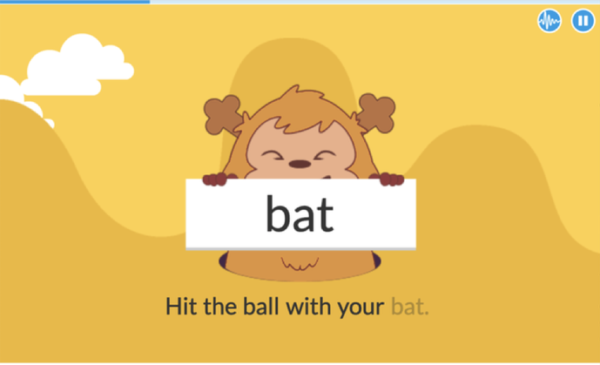
The process of placing the word in its correct place within a sentence helps the student develop accurate, rapid word recognition. The stubmunk’s reaction to the correct placement of a word reinforces the student’s behaviour, further promoting their recognition of words.
Stubmunks Sight Words Test
- automatic word recognition
The Sight Words Test combines word recognition with fun game mechanics. After hearing a word, the student is presented with four words where they need to recognise the specific word they hear. The ability to recognise a word quickly and accurately is one of the most important skills for effective, independent reading ability (Gibbon, Duffied, Hoffman & Wageman, 2017).
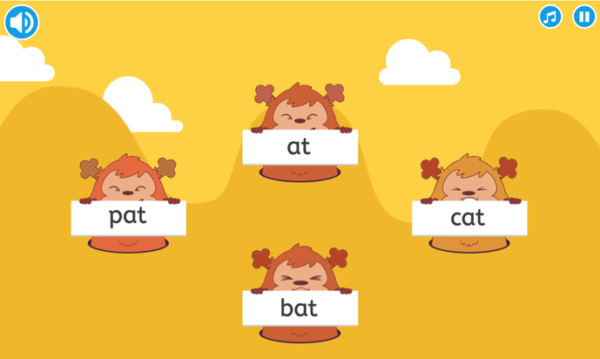
Through repeated practice and memorisation drills, the student is tested on their ability to associate the sound of a word with its graphemic representation. The delighted reaction of a stubmunk when a word is correctly identified reinforces a student’s competence and their motivation to keep learning.
WORKS CITED
Australian Curriculum, Assessment and Reporting Authority. (n.d.). Content for Foundation – Learning Area Content Descriptions. Retrieved from https://docs.acara.edu.au/resources/Content_for_Foundation_-_Learning_area_content_descriptions.pdf
Borys, M. & Laskowski, M. (2013). Implementing Game Elements Into Didactic Process: A Case Study. Paper presented at Management, Knowledge and Learning. International Conference, Zadar, Croatia (pp. 819-824). Retrieved from https://pdfs.semanticscholar.org/6285/a0b42e76f6a6d3981b59865848b08baf7b2f.pdf
Buckingham, J. (2016). Focus on Phonics: Why Australia should adopt the Year 1 Phonics Screening Check. The Centre for Independent Studies. Research Report 22. Retrieved from https://www.cis.org.au/app/uploads/2016/11/rr22.pdf
Carson, K. L. & Bayetto, A. E. (2018). Teachers’ phonological awareness assessment practices, self-reported knowledge and actual knowledge: The challenge of assessing what you may know less about. Australian Journal of Teacher Education, 43(6), 67-85.
Castles, A., Rastle, K. & Nation, K. (2018). Ending the Reading Wars: Reading Acquisition From Novice to Expert. Psychological Science in the Public Interest. 19(1), 5-51.
Dombey, H. (2011). Distorting the process of learning to read: Light touch phonics. Education Review. 23(2), 23-32.
Fielding-Barnsley, R., & Hay, I. (2012). Comparative effectiveness of phonological awareness and oral language intervention for children with low emergent literacy skills. Australian Journal of Language and Literacy, 35(3), 271-286.
Fisher, B., et al. (2007). “Look-Say-Cover-Write-Say-Check and Old Way/New Way – Mediational Learning: A Comparison of the Effectiveness of Two Tutoring Programs for Children with Persistent Spelling Difficulties.” ResearchOnline@Avondale, Retrieved from https://research.avondale.edu.au/edu_papers/31/
Fisher, D., Frey, N., & Hattie, J. (2016). Visible learning for literacy, grades K-12: implementing the practices that work best to accelerate student learning. Thousand Oaks, California: Corwin Literacy.
Fountas, I.C. & Pinnell, G.S. (2016). Guided Reading, Second Edition: Responsive Teaching Across the Grades. Portsmouth, United States: Heinemann USA.
Gibbon, J. M., Duffield, S., Hoffman, J. & Wageman, J. J. (2017). Effects of Educational Games on Sight Word Reading Achievement and Student Motivation. Journal of Language and Literacy Education. 13(2), 1-27.
Hordacre, A. L., Moretti, C. & Spoehr, J. (2017). Evaluation of the Trial of the UK Phonics Screening Check in South Australian Schools. Adelaide: Australian Industrial Transformation Institute, Flinders University of South Australia.
Konza, D. (2014). Teaching Reading: Why the “Fab Five” should be the “Big Six”. Australian Journal of Teacher Education, 39(12), 153-169.
Machin, S., McNally, S. & Viarengo, M. 2018. Changing How Literacy Is Taught: Evidence on Synthetic Phonics: Dataset. American Economic Journal: Economic Policy. 1(2). 217-241.
National Early Literacy Panel. (2008). Developing early literacy: A scientific
synthesis of early literacy development and implications for intervention. National Institute for Literacy. Retrieved from http://lincs.ed.gov/publications/pdf/(NELP) Report09.pdf
National Inquiry into the Teaching of Literacy. (2005). Teaching Reading: Report and Recommendations. Retrieved from http://www.curriculum.edu.au/leader/report_of_the_national_inquiry_into_the_teaching_o,12633.html?issueID=9803
National Reading Panel (U.S.), & National Institute of Child Health and Human Development (U.S.). (2000). Report of the National Reading Panel: Teaching children to read: an evidence-based assessment of the scientific research literature on reading and its implications for reading instruction: reports of the subgroups. Washington, D.C.: National Institute of Child Health and Human Development, National Institutes of Health.
Rose, J. (2006). Independent Review of the Teaching of Early Reading: Final Report. Department for Education and Skills. Retrieved from https://dera.ioe.ac.uk/5551/2/report.pdf





